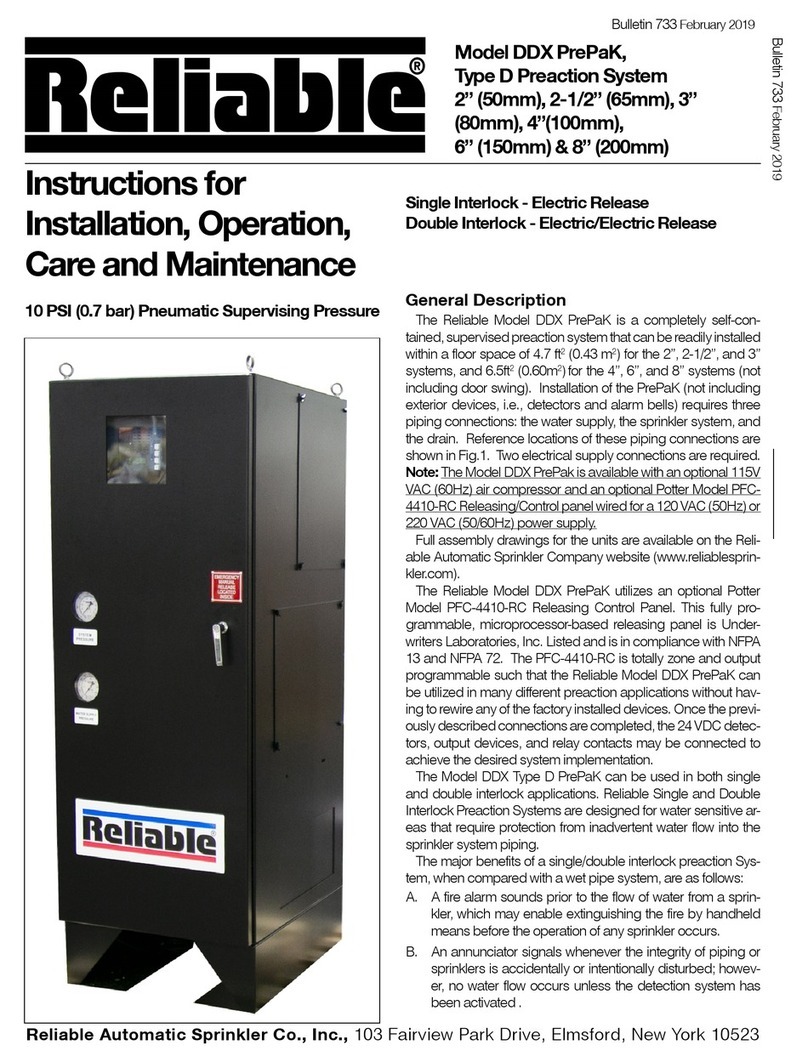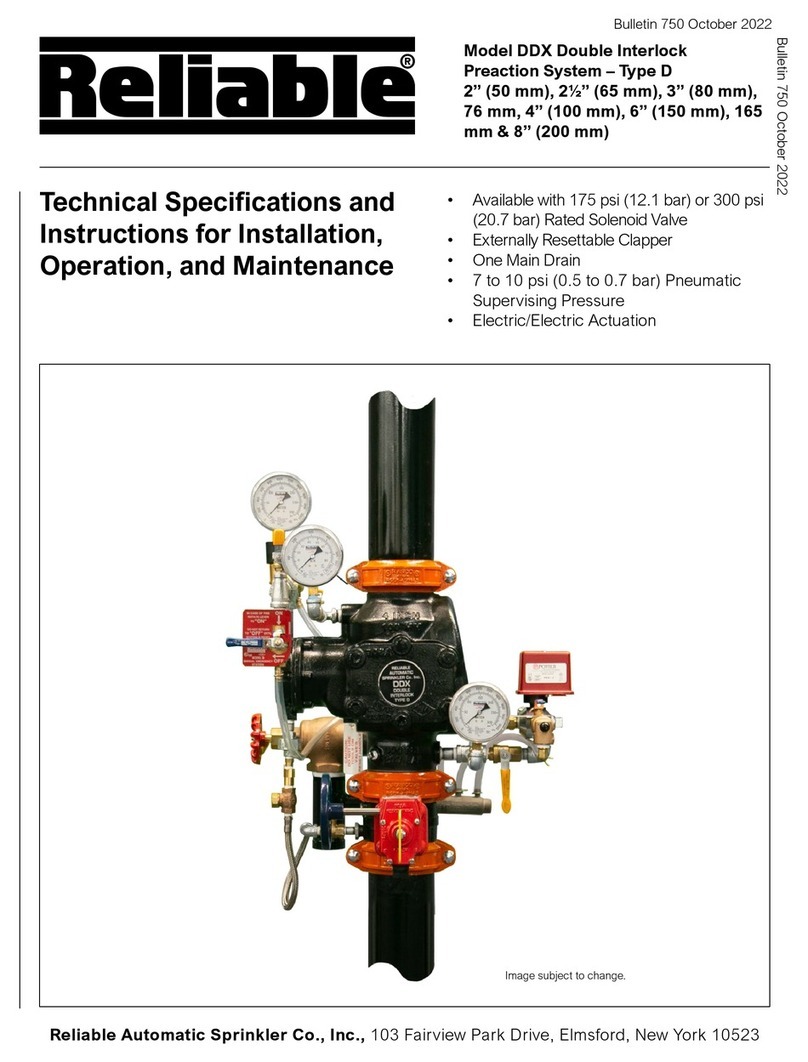
5.
Note: During system set-up, a higher pneumatic pres-
sure may be required in order to properly set the Model
LP Dry Pilot Actuator. The dew point of the air supply
must be maintained below the lowest ambient tempera-
ture to which the preaction system will be exposed. In-
troduction of moisture into the system piping exposed
to freezing temperatures can create ice blockage which
could prevent proper system operation. As a minimum,
the supply of air should be taken from the area of low-
est temperature within the protected area. The air supply
system must be carefully designed to prevent plugging
by frost deposits. Special requirements, such as those
in FME&R’s “Installation Guidelines for Refrigerated Stor-
age” may need incorporated.
Nitrogen used in refrigerated area systems minimizes a
possibility of ice build-up and blockage inside the system
piping that could inhibit proper system operation. The dew-
point of nitrogen compressed to 20 psig (1.4 bar) pressure is
-46°F (-43.3°C), and -52°F (-46.7°C) when compressed to 10
psig (0.7 bar). High-pressure nitrogen cylinders can typically
be rented from a local source, with rental fees varying by
supplier and cylinder sizes. The calculated nitrogen supply
in lbs (kg) to pressurize various system capacities to 10 psi
(0.7 bar) at different freezer temperatures is shown in Table B.
A Nitrogen Kit is available as an option, for installations where
nitrogen is used as the supervisory gas. A “low-nitrogen” LED
is mounted onto the door of the Potter Model PFC-4410-RC
Releasing/Control Panel. It will illuminate when the nitrogen
pressure switch detects that the available nitrogen supply falls
to 100 psi (6,9 bar). The nitrogen source should be replaced
promptly upon operation of the pressure switch. If the nitrogen
supply is not replaced, the entire amount of make-up air will
come solely from the unit’s air compressor (if installed).
Table B
System
Capacity
Gal. (L)
Freezer Temperature Approx.
Fill Time
(min.)*
20°F
(-6.7°C)
0°F
(-18°C)
-20°F
(-29°C)
-40°F
(-40°C)
-60°F
(-51°C)
250
(946)
1.90
(.86)
1.90
(.86)
2.00
(.90)
2.10
(.95)
2.20
(1.00) 1
500
(1891)
3.64
(1.65)
3.80
(1.72)
4.00
(1.81)
4.20
(1.91)
4.40
(2.00) 2
750
(2840)
5.50
(2.50)
5.70
(2.60)
6.00
(2.72)
6.30
(2.86)
6.60
(3.00) 3
1,000
(3785)
7.30
(3.30)
7.60
(3.44)
8.00
(3.62)
8.33
(3.78)
8.80
(4.00) 4
Note: To obtain required nitrogen supply (lbs.) for 15 psi (1.0
bar) or 22 psi (1.5 bar), multiply the tabulated values by
a factor of 1.5 or 2.2 respectively.
(1 bar = 100 kPa)
* When filled with the Rapid Air – Fill Shutoff Valve open.
If the air compressor in the Model DDX Type F PrePaK is
used to initially fill the sprinkler system with air, the steel enclo-
sure door should remain open to provide maximum intake air
flow to the air compressor. The air compressor is connected
to a storage tank. This tank functions as a reservoir, provid-
ing make-up air to compensate for small, intermittent leaks in
the sprinkler system. It should be noted that significant leaks
may overburden this storage tank, thereby causing the air
compressor to continuously cycle on and off.
The factory-installed system air pressure switch may need
on-site adjustment to correspond with the air pressure val-
ues found in Table A. Adjustment, if required, should be
made according to Potter Bulletin 5401564 included with
the switch.
System Electrical Requirements
All releasing, alarm, and detection devices in the Reli-
able Model DDX Type F PrePaK are supervised by a Potter
Model PFC-4410-RC Releasing Control Panel. All of the ter-
minals are translated to a water-tight terminal box mounted
on the interior of the enclosure. All field wiring is connected
to this terminal box. Note: The EOL (End of Line) resistors
have also been relocated.
The Reliable Model DDX PrePaK is delivered with six
factory-installed electrical devices. They consist of the fol-
lowing:
1. A system air pressure switch, which is used to monitor
sprinkler piping.
2. An alarm pressure switch, which indicates an actuation
of the deluge valve.
3. A normally-closed, releasing solenoid valve, which is
used to actuate the deluge valve.
4. A 1/2 HP (2”, 2-1/2”, & 3” valve), 1 HP (4” valve), or 1-1/2
HP (6” & 8” valve) air compressor with tank.
5. A supervised butterfly (main control) valve (Note: A sys-
tem side butterfly valve is available as an option).
6. A release control disable switch (RCDS) which is used
to disable the solenoid valve for test purposes.
The factory electrical connections of these devices,
along with information on the connection of detection devic-
es (initiating zones 1 and 2), signaling devices, and super-
visory outputs to the Potter PFC4410-RC Releasing Control
Panel are included in this bulletin. The power supply, stand-
by emergency power supply, battery charger and rectifier
circuitry are all contained within the PFC4410 panel. Bat-
teries that provide 90 hours of standby power are provided
with the panel. For additional information and detailed wiring
diagrams, please refer to Potter Manual #5403550 (Instal-
lation, Operation and Instruction of PFC4410-RC Releasing
Control Panel).
Note: In order for the solenoid valve to maintain a warranty it
must remain sealed as it came from the factory. If there are
concerns about the valve’s internal components, immediate re-
placement is recommended.
System Operation (Double Interlock)
To fully activate (discharge water from) the Reliable Model
DDX Type F PrePaK system, a fire detection device must ac-
tivate and pneumatic pressure must be lost from the sprin-
kler system piping (normally from the activation of one or
more fire sprinklers).
When the system is properly set for service, the water sup-
ply pressure simultaneously acts on both the underside of
the deluge valve’s clapper and on the valve’s push rod by
means of the pressurized push rod chamber. The resultant
pressure force acting on the push rod, in unison with the me-
chanical advantage of the deluge valve lever, is more than
sufficient to hold the valve clapper in the closed position
against the water supply pressure.






































